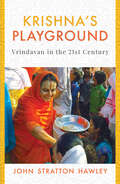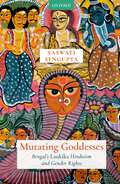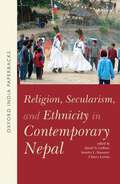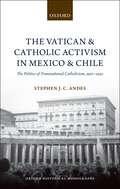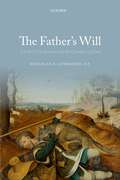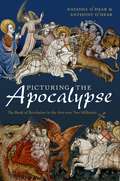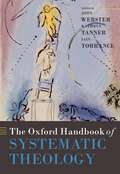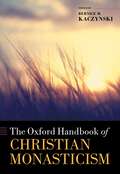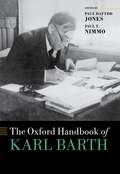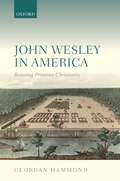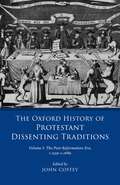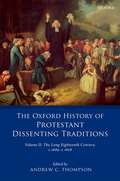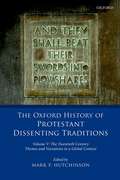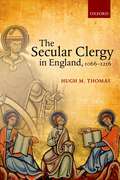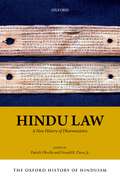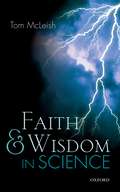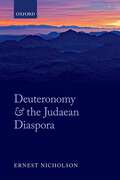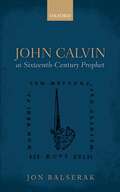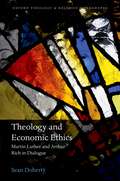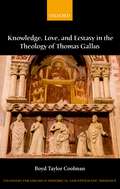- Table View
- List View
Krishna’s Playground: Vrindavan in the 21st Century
by John Stratton HawleyThis is a book about a deeply beloved place—many call it the spiritual capital of India. Located at a dramatic bend in the River Yamuna, a hundred miles from the center of Delhi, Vrindavan is the spot where the god Krishna is believed to have spent his childhood and youth. For Hindus it has always stood for youth writ large—a realm of love and beauty that enables one to retreat from the weight and harshness of the world. Now, though, the world is gobbling up Vrindavan. Delhi’s megalopolitan sprawl inches closer day by day—half the town is a vast real-estate development—and the waters of the Yamuna are too polluted to drink or even bathe in. Temples now style themselves as theme parks, and the world’s tallest religious building is under construction in Krishna’s pastoral paradise. What happens when the Anthropocene Age makes everything virtual? What happens when heaven gets plowed under? Like our age as a whole, Vrindavan throbs with feisty energy, but is it the religious canary in our collective coal mine?
Mutating Goddesses: Bengal’s Laukika Hinduism and Gender Rights
by Saswati SenguptaMutating Goddesses traces the shifting fortunes of four specific Hindu deities—Manasa, Candi, Sasthi and Laksmi—from the fifteenth century to the present time. It focuses on the goddess-invested tradition of Bengal's Hinduism to argue for a historical evolution/devolution of divinities in tandem with sectarian interests and illumines in the process the knotted correlation of gender, caste and class in the sanctioning of female subjectivities through goddess formation. The critical studies of Hindu goddesses have been dominated by the sastrik perspective deriving from the Sanskrit scriptures authorized by the male Brahman. But there are religious practices and beliefs under the broad rubric of Hinduism that are neither governed by the male Brahman nor articulated in Sanskrit. It is this vibrant laukika archive—considered low from the hegemonic perspective—that Mutating Goddesses explores to realize the politic trafficking between this realm and the sastrik. The book excavates the multiple and layered heritage of the region which includes tribal culture, Buddhism, Tantricism, and so on, as is available in rituals, proverbs, verses, circulating myths, poetic genres and kathas, caste manuals, census records etc to illustrate how tradition is a matter of strategic selection.
Religion, Secularism, and Ethnicity in Contemporary Nepal
by David N. Gellner Sondra L. Hausner Chiara LetiziaThe socio-political landscape of Nepal has been rocked by dramatic and far-reaching changes in the past thirty years. Following a ten-year Maoist revolution and civil war, the country has transitioned from a monarchy to a republic. The former Hindu kingdom has declared its commitment to secularism, without coming to any agreement on what secularism means or should mean in the Nepalese context. What happens to religion under conditions of such rapid social and political change? How do the changes in public festivals reflect and/or create new group identities? Is the gap between the urban and the rural narrowing? How is the state dealing with Nepal’s multicultural and multi-religious society? How are Nepalis understanding, resisting, and adapting ideas of secularism? In order to answer these important questions, this volume brings together eleven case studies by an international team of anthropologists and ethno-Indologists of Nepal on such diverse topics as secularism, individualism, shamanism, animal sacrifice, the role of state functionaries in festivals, clashes and synergies between Maoism and Buddhism, and conversion to Christianity. In an Afterword, renowned political theorist Rajeev Bhargava presents a comparative analysis of Nepal’s experiences and asks whether the country is finding its own solution to the conundrum of secularism.
The Vatican And Catholic Activism In Mexico And Chile: The Politics Of Transnational Catholicism, 1920-1940 (Oxford Historical Monographs)
by Stephen J. C. AndesAs in Europe, secular nation building in Latin America challenged the traditional authority of the Roman Catholic Church in the early twentieth century. In response, Catholic social and political movements sought to contest state-led secularisation and provide an answer to the 'social question', the complex set of problems associated with urbanisation, industrialisation, and poverty. As Catholics mobilised against the secular threat, they also struggled with each other to define the proper role of the Church in the public sphere. This study utilizes recently opened files at the Vatican pertaining to Mexico's post-revolutionary Church-state conflict known as the Cristero Rebellion (1926-1929). However, looking beyond Mexico's exceptional case, the work employs a transnational framework, enabling a better understanding of the supranational relationship between Latin American Catholic activists and the Vatican. To capture this world historical context, Andes compares Mexico to Chile's own experience of religious conflict. Unlike past scholarship, which has focused almost exclusively on local conditions, Andes seeks to answer how diverse national visions of Catholicism responded to papal attempts to centralize its authority and universalize Church practices worldwide. The Politics of Transnational Catholicism applies research on the interwar papacy, which is almost exclusively European in outlook, to a Latin American context. The national cases presented illuminate how Catholicism shaped public life in Latin America as the Vatican sought to define Catholic participation in Mexican and Chilean national politics. It reveals that Catholic activism directly influenced the development of new political movements such as Christian Democracy, which remained central to political life in the region for the remainder of the twentieth century.
Picturing the Apocalypse: The Book of Revelation in the Arts over Two Millennia
by Natasha O'Hear Anthony O'HearThe book of Revelation has been a source of continual fascination for nearly two thousand years. Concepts such as The Lamb of God, the Four Horsemen, the Seventh Seal, the Beasts and Antichrist, the Whore of Babylon, Armageddon, the Millennium, the Last Judgement, the New Jerusalem, and the ubiquitous Angel of the Apocalypse have captured the popular imagination. One can hardly open a newspaper or click on a news web site without reading about impending financial or climate change Armageddon, while the concept of the Four Horsemen pervades popular music, gaming, and satire. Yet few people know much about either the basic meaning or original context of these concepts or the multiplicity of different ways in which they have been interpreted by visual artists in particular. The visual history of this most widely illustrated of all the biblical books deserves greater attention. This book fills these gaps in a striking and original way by means of ten concise thematic chapters which explain the origins of these concepts from the book of Revelation in an accessible way. These explanations are augmented and developed via a carefully selected sample of the ways in which the concepts have been treated by artists through the centuries. The 120 visual examples are drawn from a wide range of time periods and media including the ninth-century Trier Apocalypse, thirteenth-century Anglo-Norman Apocalypse Manuscripts such as the Lambeth and Trinity Apocalypses, the fourteenth-century Angers Apocalypse Tapestry, fifteenth-century Apocalypse altarpieces by Van Eyck and Memling, Dürer and Cranach's sixteenth-century Apocalypse woodcuts, and more recently a range of works by William Blake, J. M. W. Turner, Max Beckmann, as well as film posters and stills, cartoons, and children's book illustrations. The final chapter demonstrates the continuing resonance of all the themes in contemporary religious, political, and popular thinking, while throughout the book a contrast will be drawn between those readers of Revelation who have seen it in terms of earthly revolutions in the here and now, and those who have adopted a more spiritual, otherworldly approach.
Picturing the Apocalypse: The Book of Revelation in the Arts over Two Millennia
by Anthony O'Hear Natasha O'HearThe book of Revelation has been a source of continual fascination for nearly two thousand years. Concepts such as The Lamb of God, the Four Horsemen, the Seventh Seal, the Beasts and Antichrist, the Whore of Babylon, Armageddon, the Millennium, the Last Judgement, the New Jerusalem, and the ubiquitous Angel of the Apocalypse have captured the popular imagination. One can hardly open a newspaper or click on a news web site without reading about impending financial or climate change Armageddon, while the concept of the Four Horsemen pervades popular music, gaming, and satire. Yet few people know much about either the basic meaning or original context of these concepts or the multiplicity of different ways in which they have been interpreted by visual artists in particular. The visual history of this most widely illustrated of all the biblical books deserves greater attention. This book fills these gaps in a striking and original way by means of ten concise thematic chapters which explain the origins of these concepts from the book of Revelation in an accessible way. These explanations are augmented and developed via a carefully selected sample of the ways in which the concepts have been treated by artists through the centuries. The 120 visual examples are drawn from a wide range of time periods and media including the ninth-century Trier Apocalypse, thirteenth-century Anglo-Norman Apocalypse Manuscripts such as the Lambeth and Trinity Apocalypses, the fourteenth-century Angers Apocalypse Tapestry, fifteenth-century Apocalypse altarpieces by Van Eyck and Memling, Dürer and Cranach's sixteenth-century Apocalypse woodcuts, and more recently a range of works by William Blake, J. M. W. Turner, Max Beckmann, as well as film posters and stills, cartoons, and children's book illustrations. The final chapter demonstrates the continuing resonance of all the themes in contemporary religious, political, and popular thinking, while throughout the book a contrast will be drawn between those readers of Revelation who have seen it in terms of earthly revolutions in the here and now, and those who have adopted a more spiritual, otherworldly approach.
Systematic Theology: Herman Bavinck's Theological Epistemology (T&t Clark Studies In Systematic Theology Ser. #33)
by John Webster Kathryn Tanner Iain TorranceThe Oxford Handbook of Systematic Theology brings together a set of original and authoritative accounts of all the major areas of current research in Christian systematic theology, offering a thorough survey of the state of the discipline and of its prospects for those undertaking research and teaching in the field. The Handbook engages in a comprehensive examination of themes and approaches, guiding the reader through current debates and literatures in the context of the historical development of systematic theological reflection. Organized thematically, it treats in detail the full array of topics in systematic theology, as well as questions of its sources and norms, its relation to other theological and non-theological fields of enquiry, and some major trends in current work. Each chapter provides an analysis of research and debate on its topic. The focus is on doctrinal (rather than historical) questions, and on major (rather than ephemeral) debates. The aim is to stimulate readers to reach theological judgements on the basis of consideration of the range of opinion. Drawn from Europe, the UK, and North America, the authors are all leading practitioners of the discipline. Readers will find expert guidance as well as creative suggestions about the future direction of the study of Christian doctrine.
The Oxford Handbook of Christian Monasticism (Oxford Handbooks)
by Thomas SullivanThe Handbook takes as its subject the complex phenomenon of Christian monasticism. It addresses, for the first time in one volume, the multiple strands of Christian monastic practice. Forty-four essays consider historical and thematic aspects of the Catholic, Eastern Orthodox, Oriental Orthodox, Protestant, and Anglican traditions, as well as contemporary 'new monasticism'. The essays in the book span a period of nearly two thousand years—from late ancient times, through the medieval and early modern eras, on to the present day. Taken together, they offer, not a narrative survey, but rather a map of the vast terrain. The intention of the Handbook is to provide a balance of some essential historical coverage with a representative sample of current thinking on monasticism. It presents the work of both academic and monastic authors, and the essays are best understood as a series of loosely-linked episodes, forming a long chain of enquiry, and allowing for various points of view. The authors are a diverse and international group, who bring a wide range of critical perspectives to bear on pertinent themes and issues. They indicate developing trends in their areas of specialisation. The individual contributions, and the volume as a whole, set out an agenda for the future direction of monastic studies. In today's world, where there is increasing interest in all world monasticisms, where scholars are adopting more capacious, global approaches to their investigations, and where monks and nuns are casting a fresh eye on their ancient traditions, this publication is especially timely.
The Oxford Handbook of Christian Monasticism (Oxford Handbooks)
by Thomas SullivanThe Handbook takes as its subject the complex phenomenon of Christian monasticism. It addresses, for the first time in one volume, the multiple strands of Christian monastic practice. Forty-four essays consider historical and thematic aspects of the Catholic, Eastern Orthodox, Oriental Orthodox, Protestant, and Anglican traditions, as well as contemporary 'new monasticism'. The essays in the book span a period of nearly two thousand years—from late ancient times, through the medieval and early modern eras, on to the present day. Taken together, they offer, not a narrative survey, but rather a map of the vast terrain. The intention of the Handbook is to provide a balance of some essential historical coverage with a representative sample of current thinking on monasticism. It presents the work of both academic and monastic authors, and the essays are best understood as a series of loosely-linked episodes, forming a long chain of enquiry, and allowing for various points of view. The authors are a diverse and international group, who bring a wide range of critical perspectives to bear on pertinent themes and issues. They indicate developing trends in their areas of specialisation. The individual contributions, and the volume as a whole, set out an agenda for the future direction of monastic studies. In today's world, where there is increasing interest in all world monasticisms, where scholars are adopting more capacious, global approaches to their investigations, and where monks and nuns are casting a fresh eye on their ancient traditions, this publication is especially timely.
The Oxford Handbook of Karl Barth (Oxford Handbooks)
Karl Barth (1886-1968) is generally acknowledged to be the most important European Protestant theologian of the twentieth century, a figure whose importance for Christian thought compares with that of Augustine, Thomas Aquinas, John Calvin, Martin Luther, and Friedrich Schleiermacher. Author of the Epistle to the Romans, the multi-volume Church Dogmatics, and a wide range of other works - theological, exegetical, historical, political, pastoral, and homiletic - Barth has had significant and perduring influence on the contemporary study of theology and on the life of contemporary churches. In the last few decades, his work has been at the centre of some of the most important interpretative, critical, and constructive developments in in the fields of Christian theology, philosophy of religion, and religious studies. The Oxford Handbook of Karl Barth is the most expansive guide to Barth's work published to date. Comprising over forty original chapters, each of which is written by an expert in the field, the Handbook provides rich analysis of Barth's life and context, advances penetrating interpretations of the key elements of his thought, and opens and charts new paths for critical and constructive reflection. In the process, it seeks to illuminate the complex and challenging world of Barth's theology, to engage with it from multiple perspectives, and to communicate something of the joyful nature of theology as Barth conceived it. It will serve as an indispensable resource for undergraduates, postgraduates, academics, and general readers for years to come.
The Oxford Handbook of Karl Barth (Oxford Handbooks)
by Paul T. Nimmo Paul Dafydd JonesKarl Barth (1886-1968) is generally acknowledged to be the most important European Protestant theologian of the twentieth century, a figure whose importance for Christian thought compares with that of Augustine, Thomas Aquinas, John Calvin, Martin Luther, and Friedrich Schleiermacher. Author of the Epistle to the Romans, the multi-volume Church Dogmatics, and a wide range of other works - theological, exegetical, historical, political, pastoral, and homiletic - Barth has had significant and perduring influence on the contemporary study of theology and on the life of contemporary churches. In the last few decades, his work has been at the centre of some of the most important interpretative, critical, and constructive developments in in the fields of Christian theology, philosophy of religion, and religious studies. The Oxford Handbook of Karl Barth is the most expansive guide to Barth's work published to date. Comprising over forty original chapters, each of which is written by an expert in the field, the Handbook provides rich analysis of Barth's life and context, advances penetrating interpretations of the key elements of his thought, and opens and charts new paths for critical and constructive reflection. In the process, it seeks to illuminate the complex and challenging world of Barth's theology, to engage with it from multiple perspectives, and to communicate something of the joyful nature of theology as Barth conceived it. It will serve as an indispensable resource for undergraduates, postgraduates, academics, and general readers for years to come.
John Wesley In America: Restoring Primitive Christianity
by Geordan HammondWhy did John Wesley leave the halls of academia at Oxford to become a Church of England missionary in the newly established colony of Georgia? Was his ministry in America a success or failure? These questions-which have engaged numerous biographers of Wesley-have often been approached from the vantage point of later developments in Methodism. Geordan Hammond presents the first book-length study of Wesley's experience in America, providing an innovative contribution to debates about the significance of a formative period of Wesley's life. John Wesley in America addresses Wesley's Georgia mission in fresh perspective by interpreting it in its immediate context. In order to re-evaluate this period of Wesley's life, Hammond carefully considers Wesley's writings and those of his contemporaries. The Georgia mission, for Wesley, was a laboratory for implementing his views of primitive Christianity. The ideal of restoring the doctrine, discipline, and practice of the early church in the pristine Georgia wilderness was the prime motivating factor in Wesley's decision to embark for Georgia and in his clerical practice in the colony. Understanding the centrality of primitive Christianity to Wesley's thinking and pastoral methods is essential to comprehending his experience in America. Wesley's conception of primitive Christianity was rooted in his embrace of patristic scholarship at Oxford. The most direct influence, however, was the High Church ecclesiology of the Usager Nonjurors who inspired him with their commitment to the restoration of the primitive church.
The Oxford History of Protestant Dissenting Traditions, Volume I: The Post-Reformation Era, 1559-1689 (The Oxford History of Protestant Dissenting Traditions)
The Oxford History of Protestant Dissenting Traditions, Volume I traces the emergence of Anglophone Protestant Dissent in the post-Reformation era between the Act of Uniformity (1559) and the Act of Toleration (1689). It reassesses the relationship between establishment and Dissent, emphasising that Presbyterians and Congregationalists were serious contenders in the struggle for religious hegemony. Under Elizabeth I and the early Stuarts, separatists were few in number, and Dissent was largely contained within the Church of England, as nonconformists sought to reform the national Church from within. During the English Revolution (1640-60), Puritan reformers seized control of the state but splintered into rival factions with competing programmes of ecclesiastical reform. Only after the Restoration, following the ejection of two thousand Puritan clergy from the Church, did most Puritans become Dissenters, often with great reluctance. Dissent was not the inevitable terminus of Puritanism, but the contingent and unintended consequence of the Puritan drive for further reformation. The story of Dissent is thus bound up with the contest for the established Church, not simply a heroic tale of persecuted minorities contending for religious toleration. Nevertheless, in the half century after 1640, religious pluralism became a fact of English life, as denominations formed and toleration was widely advocated. The volume explores how Presbyterians, Congregationalists, Baptists, and Quakers began to forge distinct identities as the four major denominational traditions of English Dissent. It tracks the proliferation of Anglophone Protestant Dissent beyond England—in Wales, Scotland, Ireland, the Dutch Republic, New England, Pennsylvania, and the Caribbean. And it presents the latest research on the culture of Dissenting congregations, including their relations with the parish, their worship, preaching, gender relations, and lay experience.
The Oxford History of Protestant Dissenting Traditions, Volume II: The Long Eighteenth Century c. 1689-c. 1828 (The Oxford History of Protestant Dissenting Traditions)
The five-volume Oxford History of Dissenting Protestant Traditions series is governed by a motif of migration ('out-of-England'). It first traces organized church traditions that arose in England as Dissenters distanced themselves from a state church defined by diocesan episcopacy, the Book of Common Prayer, the Thirty-Nine Articles, and royal supremacy, but then follows those traditions as they spread beyond England -and also traces newer traditions that emerged downstream in other parts of the world from earlier forms of Dissent. Secondly, it does the same for the doctrines, church practices, stances toward state and society, attitudes toward Scripture, and characteristic patterns of organization that also originated in earlier English Dissent, but that have often defined a trajectory of influence independent ecclesiastical organizations. The Oxford History of Protestant Dissenting Traditions, Volume II charts the development of protestant Dissent between the passing of the Toleration Act (1689) and the repealing of the Test and Corporation Acts (1828). The long eighteenth century was a period in which Dissenters slowly moved from a position of being a persecuted minority to achieving a degree of acceptance and, eventually, full political rights. The first part of the volume considers the history of various dissenting traditions inside England. There are separate chapters devoted to Presbyterians, Congregationalists, Baptists and Quakers—the denominations that traced their history before this period—and also to Methodists, who emerged as one of the denominations of 'New Dissent' during the eighteenth century. The second part explores that ways in which these traditions developed outside England. It considers the complexities of being a Dissenter in Wales and Ireland, where the state church was Episcopalian, as well as in Scotland, where it was Presbyterian. It also looks at the development of Dissent across the Atlantic, where the relationship between church and state was rather looser. Part three is devoted to revivalist movements and their impact, with a particular emphasis on the importance of missionary societies for spreading protestant Christianity from the late eighteenth century onwards. The fourth part looks at Dissenters' relationship to the British state and their involvement in the campaigns to abolish the slave trade. The final part discusses how Dissenters lived: the theology they developed and their attitudes towards scripture; the importance of both sermons and singing; their involvement in education and print culture and the ways in which they expressed their faith materially through their buildings.
The Oxford History of Protestant Dissenting Traditions, Volume V: The Twentieth Century: Themes and Variations in a Global Context (The Oxford History of Protestant Dissenting Traditions)
The five-volume Oxford History of Protestant Dissenting Traditions series is governed by a motif of migration ('out-of-England'). It first traces organized church traditions that arose in Britain and Ireland as Dissenters distanced themselves from a state church defined by diocesan episcopacy, the Book of Common Prayer, the Thirty-Nine Articles, and Royal Supremacy, but then follows those traditions as they spread beyond Britain and Ireland—and also analyses newer traditions that emerged downstream in other parts of the world from earlier forms of Dissent. Secondly, it does the same for the doctrines, church practices, stances toward state and society, attitudes toward Scripture, and characteristic patterns of organization that also originated in earlier British and Irish dissent, but that have often defined a trajectory of influence independent of ecclesiastical organizations. The Oxford History of Protestant Dissenting Traditions, Volume V follows the spatial, cultural, and intellectual changes in dissenting identity and practice in the twentieth century, as these once European traditions globalized. While in Europe dissent was often against the religious state, dissent in a globalizing world could redefine itself against colonialism or other secular and religious monopolies. The contributors trace the encounters of dissenting Protestant traditions with modernity and globalization; changing imperial politics; challenges to biblical, denominational, and pastoral authority; local cultures and languages; and some of the century's major themes, such as race and gender, new technologies, and organizational change. In so doing, they identify a vast array of local and globalizing illustrations which will enliven conversations about the role of religion, and in particular Christianity.
The Secular Clergy In England, 1066-1216
by Hugh M. ThomasThe secular clergy - priests and other clerics outside of monastic orders - were among the most influential and powerful groups in European society during the central Middle Ages. The secular clergy got their title from the Latin word for world, saeculum, and secular clerics kept the Church running in the world beyond the cloister wall, with responsibility for the bulk of pastoral care and ecclesiastical administration. This gave them enormous religious influence, although they were considered too worldly by many contemporary moralists - trying, for instance, to oppose the elimination of clerical marriage and concubinage. Although their worldliness created many tensions, it also gave the secular clergy much worldly influence. Contemporaries treated elite secular clerics as equivalent to knights, and some were as wealthy as minor barons. Secular clerics had a huge role in the rise of royal bureaucracy, one of the key historical developments of the period. They were instrumental to the intellectual and cultural flowering of the twelfth century, the rise of the schools, the creation of the book trade, and the invention of universities. They performed music, produced literature in a variety of genres and languages, and patronized art and architecture. Indeed, this volume argues that they contributed more than any other group to the Twelfth-Century Renaissance. Yet the secular clergy as a group have received almost no attention from scholars, unlike monks, nuns, or secular nobles. In The Secular Clergy in England, 1066-1216, Hugh Thomas aims to correct this deficiency through a major study of the secular clergy below the level of bishop in England from 1066 to 1216.
The Oxford History of Hinduism: A New History of Dharmaśāstra (The Oxford History Of Hinduism)
Through pointed studies of important aspects and topics of dharma in Dharmaśāstra, this comprehensive collection shows that the history of Hinduism cannot be written without the history of Hindu law. Part One provides a concise overview of the literary genres in which Dharmasastra was written with attention to chronology and historical developments. This study divides the tradition into its two major historical periods—the origins and formation of the classical texts and the later genres of commentary and digest—in order to provide a thorough, but manageable overview of the textual bases of the tradition. Part Two presents descriptive and historical studies of all the major substantive topics of Dharmasastra. Each chapter offers readers with salest knowledge of the debates, transformations, and fluctcating importance of each topic. Indirectly, readers will also gain insight into the ethos or worldview of religious law in Hinduism, enabling them to get a feel for how dharma authors thought and why. Part Three contains brief studies of the impact and reception of Dharmasastra in other South Asian cultural and textual traditions. Finally, Part Four draws inspiration from "critical terms" in contemporary legal and religious studies to analyze Dharmasastra texts. Contributors offer interpretive views of Dharmasastra that start from hermeneutic and social concerns today.
The Oxford History of Hinduism: A New History of Dharmaśāstra (The Oxford History Of Hinduism)
by Patrick Olivelle Donald R. DavisThrough pointed studies of important aspects and topics of dharma in Dharmaśāstra, this comprehensive collection shows that the history of Hinduism cannot be written without the history of Hindu law. Part One provides a concise overview of the literary genres in which Dharmasastra was written with attention to chronology and historical developments. This study divides the tradition into its two major historical periods—the origins and formation of the classical texts and the later genres of commentary and digest—in order to provide a thorough, but manageable overview of the textual bases of the tradition. Part Two presents descriptive and historical studies of all the major substantive topics of Dharmasastra. Each chapter offers readers with salest knowledge of the debates, transformations, and fluctcating importance of each topic. Indirectly, readers will also gain insight into the ethos or worldview of religious law in Hinduism, enabling them to get a feel for how dharma authors thought and why. Part Three contains brief studies of the impact and reception of Dharmasastra in other South Asian cultural and textual traditions. Finally, Part Four draws inspiration from "critical terms" in contemporary legal and religious studies to analyze Dharmasastra texts. Contributors offer interpretive views of Dharmasastra that start from hermeneutic and social concerns today.
Faith and Wisdom in Science
by Tom McLeish"Can you Count the Clouds?" asks the voice of God from the whirlwind in the stunningly beautiful catalogue of nature-questions from the Old Testament Book of Job. Tom McLeish takes a scientist's reading of this ancient text as a centrepiece to make the case for science as a deeply human and ancient activity, embedded in some of the oldest stories told about human desire to understand the natural world. Drawing on stories from the modern science of chaos and uncertainty alongside medieval, patristic, classical and Biblical sources, Faith and Wisdom in Science challenges much of the current 'science and religion' debate as operating with the wrong assumptions and in the wrong space. Its narrative approach develops a natural critique of the cultural separation of sciences and humanities, suggesting an approach to science, or in its more ancient form natural philosophy - the 'love of wisdom of natural things' - that can draw on theological and cultural roots. Following the theme of pain in human confrontation with nature, it develops a 'Theology of Science', recognising that both scientific and theological worldviews must be 'of' each other, not holding separate domains. Science finds its place within an old story of participative reconciliation with a nature, of which we start ignorant and fearful, but learn to perceive and work with in wisdom. Surprisingly, science becomes a deeply religious activity. There are urgent lessons for education, the political process of decision-making on science and technology, our relationship with the global environment, and the way that both religious and secular communities alike celebrate and govern science.
Faith and Wisdom in Science
by Tom McLeish"Can you Count the Clouds?" asks the voice of God from the whirlwind in the stunningly beautiful catalogue of nature-questions from the Old Testament Book of Job. Tom McLeish takes a scientist's reading of this ancient text as a centrepiece to make the case for science as a deeply human and ancient activity, embedded in some of the oldest stories told about human desire to understand the natural world. Drawing on stories from the modern science of chaos and uncertainty alongside medieval, patristic, classical and Biblical sources, Faith and Wisdom in Science challenges much of the current 'science and religion' debate as operating with the wrong assumptions and in the wrong space. Its narrative approach develops a natural critique of the cultural separation of sciences and humanities, suggesting an approach to science, or in its more ancient form natural philosophy - the 'love of wisdom of natural things' - that can draw on theological and cultural roots. Following the theme of pain in human confrontation with nature, it develops a 'Theology of Science', recognising that both scientific and theological worldviews must be 'of' each other, not holding separate domains. Science finds its place within an old story of participative reconciliation with a nature, of which we start ignorant and fearful, but learn to perceive and work with in wisdom. Surprisingly, science becomes a deeply religious activity. There are urgent lessons for education, the political process of decision-making on science and technology, our relationship with the global environment, and the way that both religious and secular communities alike celebrate and govern science.
Deuteronomy And The Judaean Diaspora
by Ernest NicholsonIn Deuteronomy and the Judaean Diaspora Ernest Nicholson challenges the widely accepted view that Deuteronomy was the 'book of the law' described in 2 Kings 22-3 as the basis of king Josiah's cultic reformation in 621 BCE. He argues that the notice in this narrative that Josiah abolished the rural, local altars throughout Judah and supposedly relocated their priests to Jerusalem is based upon a misreading. Rather, he contends, Deuteronomy derived from thinkers and writers who lived among the Judaean exiles in Babylonia in the sixth century, and in significant ways represents a break with pre-exilic Israelite religion occasioned by the urgent need to confront the challenges to national identity and cultural survival of the Judaean Diaspora community. Leading features of the book such as its zealous monolatry, its self-presentation as 'scripture', its concept of the relationship with God as covenanted choice, its pervasive fear of religious encroachment, its character as 'oppositional' literature—these and other themes of the book suggest such a provenance. Issues arising include, for example, information from Babylonian sources, some of it new, about the Judaean exiles, how Israel is characterised in the book, kingship, evidence of the emergence of a body of prophetic 'scripture'. Two final chapters examine the 'Deuteronomistic History' (Joshua-2 Kings) and show that (contrary to some interpretations) it is not 'historiography' such as is represented by, for example, Herodotus' Histories, and that theodicy rather than an interest in the past as a field of critical study best describes its genre.
John Calvin As Sixteenth-century Prophet
by Jon BalserakJohn Calvin as Sixteenth-Century Prophet examines Calvin's sense of vocation. Jon Balserak argues that Calvin believed himself to be a prophet "placed over nations and kingdoms to tear down and destroy, to build and to plant" (Jer 1: 10). With this authority, Calvin pursued an expansionist agenda which blended the religious, political, and social towards making France, upon which he turned his attentions especially after 1555, Protestant. Beginning with an analysis of the two trajectories of thought existing within Christian discourse on prophecy from the patristic to the Early Modern era, this study goes on to locate Calvin within a non-mystical, non-apocalyptic prophetic tradition that focused on scriptural interpretation. Balserak demonstrates how Calvin developed a plan to win France for the gospel; a plan which included the possibility of armed conflict. To pursue his designs, Calvin trained "prophets" who were sent into France to labor intensely to undermine the king's authority on the grounds that he supported idolatry, convince the French Reformed congregations that they were already in a war with him, and prepare them for a possible military uprising. An additional part of this plan saw Calvin search for a French noble willing to support the evangelical religion, even if it meant initiating a coup. Calvin began ruminating over these ideas in the 1550s or possibly earlier. In this analysis, the war which commenced in 1562 represents the culmination of Calvin's years of preparation.
Theology And Economic Ethics: Martin Luther And Arthur Rich In Dialogue (Oxford Theology and Religion Monographs)
by Sean DohertyIn the wake of the economic crisis, few questions are more pressing than those around the ethics of finance and economics. Theology and Economic Ethics seeks to expand the self-critical resources of contemporary theological economic ethics by bringing the method of a pre-modern thinker, Martin Luther (1483-1546), into interaction with that of a modern contribution to social ethics, the Swiss theologian Arthur Rich (1910-92). The work is undertaken through a close engagement with a selected publication of Luther (his 1519/20 Großer Sermon von dem Wucher) and of Rich (his masterwork, Wirtschaftsethik, published in two volumes in 1984 and 1990 respectively). It is the first substantial treatment in English of Rich's magnum opus. Sean Doherty introduces Luther's sermon on usury, situates it in its context, then provides a commentary on this work, discussing how Luther brings key theological motifs to bear on a particular economic question. The study proceeds with a sketch of Arthur Rich's life and work, and presents Rich's method as set out in Wirtschaftsethik. Doherty illuminates Rich's understanding of ethics, his approach to Scripture, and his adoption of the thought of Max Weber and John Rawls. Bringing insights from the study of Luther to bear in an analysis of Rich's method, Doherty questions some of Rich's assumptions, and notes ways in which a more self-critical approach could have made his project more successful. Finally, the book makes tentative suggestions as to the wider applicability of these findings for a Christian approach to economic ethics.
Knowledge, Love, and Ecstasy in the Theology of Thomas Gallus (Changing Paradigms in Historical and Systematic Theology)
by Boyd Taylor CoolmanKnowledge, Love, and Ecstasy in the Theology of Thomas Gallus provides the first full study of Thomas Gallus (d. 1246) in English and represents a significant advance in his distinctive theology. Boyd Taylor Coolman argues that Gallus distinguishes, but never separates and intimately relates two international modalities in human consciousness: the intellective and the affective, both of which are forms of cognition. Coolman shows that Gallus conceives these two cognitive modalities as co-existing in an interdependent manner, and that this reciprocity is given a particular character by Gallus anthropological appropriation of the Dionysian concept of hierarchy. Because Gallus conceives of the soul as hierarchized on the model of the angelic hierarchy, the intellect-affect relationship is fundamentally governed by the dynamism of a Dionysian hierarchy, which has two simultaneous trajectories: ascending and descending. Two crucial features are noteworthy in this regard: in ascending, firstly, the lower is subsumed by the higher; in descending, secondly, the higher communicates with the lower, according to the nature of the lower. When Gallus posits a higher, affective cognitio above an intellective cognitio at the highest point in the ascent, accordingly, this higher affective form both builds upon and sublimates the lower intellective form. At the same time, this affective cognitio descends back down into the soul, both enriching its properly intellective capacity and also renewing the ascending movement in love. For Gallus, then, in the hierarchized soul a dynamic mutuality between intellect and affect emerges, which he construes as a spiralling motion, by which the soul unceasingly stretches beyond itself, ecstatically, in knowing and loving God.
